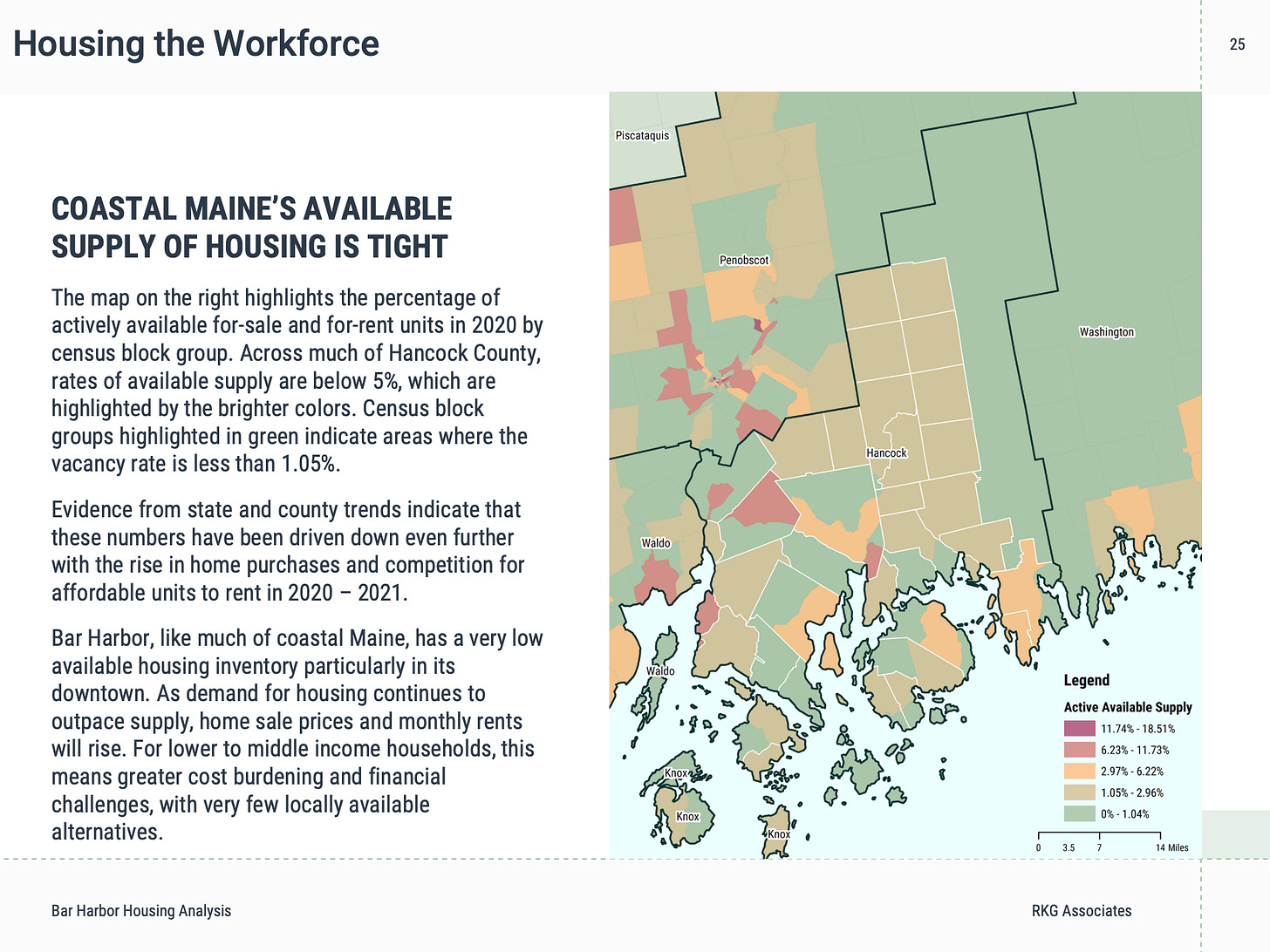Can a Town Pass the Halloween Test?
Housing needs dominate League of Towns' discussion this week
TRENTON—When he’s trying to determine the health of his year-round neighborhood, Noel Musson has a Halloween test. He walks around Southwest Harbor and notices the houses. Which are still full. Which aren’t. Are there places where his kids once trick-or-treated that are no longer being used as homes? An equally good question might be: are there enough kids to gallivant around the neighborhoods that seem Halloween friendly.
Mount Desert Town Manager Durlin Lunt doesn’t use the Halloween Test; he uses his personal experience.
“Seventy units of housing that had been when I was growing up had been year round, those seventy had gone to seasonal,” Lunt said.
“Housing really transcends all of our communities,” Musson said February 27 as the League of Towns met at the Trenton Town Office and Musson and Susanne Paul of the Musson Group spoke about housing needs and strategies in the area.
The League is a collaboration of government representatives from Bar Harbor, Cranberry Isles, Ellsworth, Lamoine, Mount Desert, Southwest Harbor, Swans Island, Tremont, Trenton, and Acadia National Park.
The discussion came at an auspicious time. According to an October report by the state, Maine needs to build 76,000 homes and build them by 2030. For Bar Harbor, a report by RKG says that number locally is 616 (housing units) by 2033.
Census data illustrates that Maine is leading New England in per capita units being built, with 5.1 units for every 1,000. By comparison, New Hampshire’s rate was 3.4.
Maine Public reports that “Gov. Janet Mills has proposed spending $10 million of a more than $250 million surplus on a program that provides zero-interest, forgivable loans for construction of affordable house complexes.”
Much of the League meeting discussed short-term rentals. Bar Harbor has a cap. Mount Desert is investigating a cap. Tremont is thinking of registering units.
“You’re not going to solve all the problems by looking at short-term rentals,” Musson said and added that it will, however, help solve some of them.
The housing problem is multi-pronged and short-term rentals are a part of it, Musson said. “It’s one slice in the pie of affordability that we need to tackle.”
That pie includes housing costs, supply costs, property taxes, and demand pressures.
“Housing is becoming less affordable,” Musson said. Retirees are staying in homes longer, but there still needs to be people moving in to fill those jobs. There’s also a seasonal housing demand, which increases the overall demand.
“Coastal Maine communities were already low producing,” he said, when it comes to homes.
“One of the big problems is so much of the former year-round housing has moved over to seasonal,” Lunt said. “That leaves only so much space to create housing.”
And then density issues in neighborhoods often causes push-back against building new homes.
In his area, Lunt said, he imagines the shift would be from short-term rentals to seasonal homes not short-term to the workforce homes.
Musson said that there are ways to approach the problems Lunt expresses: building rules and regulations in towns and also public relations.
Thinking about regulations in towns can help, Musson said. So can thinking about maximum lot sizes instead of minimum sizes for zoning rules.
When it comes to public relations, the question is often about what is it that people are struggling with about a project? Why are projects becoming opposed? Recently, in Bar Harbor, some Town Hill residents worried about both a proposed 14-home subdivision off the Crooked Road as well as potential land use amendments that could expanding some types of lodging (employee living quarters, shared accommodations) into Town Hill and some rural areas of Bar Harbor. Opponents spoke of both the water table worries in the area, ecological impact, as well as the character of those portions of the town.
Another aspect of public relations, he said, is that there’s also a learned helplessness about housing on MDI. People don’t think there are ways to solve the housing issues or ways to live on the island. That can increase pressure on surrounding communities like Trenton and Lamoine. That can strain resources, increase traffic congestion, and impact the housing stock in other towns.
“It’s a housing problem. It’s a business problem. It’s a sustainability problem,” Musson said.
A project can check all the boxes and still be opposed by a community.
PUBLIC-PRIVATE PARTNERSHIPS
The Musson Group is working with multiple towns and others. The group has held a housing summit and is talking with Island Housing Trust on a possible lease to locals program.
“You are creating an incentive to rent your short-term rental year round,” Paul said.
In a lease to locals program, home owners are paid the equivalent to what they’d make for short-term rentals to instead rent the home for a year. Or, home owners receive a stipend to incentivize them to lease the house to a local for a year.
Costs for existing similar programs in other towns and cities are funded by things like local option sales tax, public funding, donations. The Musson Group is also working on a possible housing trust fund model to support the program. This would be a shared pot of money funded from STR fees and other mechanisms (like a portion of a real estate tax).
A park representative said that last year, Acadia National Park tried to do a type of lease to locals program but was unable to find people to participate.
A lease to locals program in Summit County, Colorado which began in 2021 is ending this year because of the high cost. A lease to locals program in Truckee, California that began in 2020 is still going strong. A program in South Lake Tahoe has unlocked 38 properties and housed 91 people.
Friends of Acadia has been working with the park to help create housing solutions such as adding bedrooms to existing housing; purchasing lodging and commercial businesses to convert to seasonal housing; building new housing within the park; adding RV spots in park campgrounds.
Across the country, the National Park Foundation and National Park Service announced a $40-million gift to help with employee housing at Yellowstone National Park.
According to the NPF, “The new investment made possible by donors who wish to remain anonymous will fund more than 70 new modular units to address the critical shortage of employee housing at the park.”
A National Park Foundation assessment found that there are desperate needs at three national parks, Acadia, Yosemite, and Grand Teton. Those parks need “more than $115 million in funding to add over 200 new employee housing units,” according to representatives.
The Musson Group is also working with RKG Consultants and trying to raise the money to extend the Bar Harbor study to the rest of the region. That would cost approximately $20,000.
The group at the League of Towns’ meeting became nostalgic talking about Southwest Harbor of the past, worrying about how many homes that are being built are incredibly expensive.
“It feels hopeless,” one woman said.
“It does feel hopeless, but does that mean that we shouldn’t try to do something about it?” Musson said.
LINKS TO LEARN MORE
Friends of Acadia housing article
MDI Housing Solutions (this link was added after the initial story)











Thank you for reporting on this...and that the graphics have qualifiers. Honestly, I don't know why I bother with the Islander anymore.
What is the demographic of the people who will boost the population of BH to 6300? I don't think it will be young families because of the housing cost. I'll bet it will be retirees living here seasonally and young professionals with no children. We have lost our neighborhoods and there is no way to turn the hands of time back. My boys are 42-50yo and grew up in a neighborhood on Ledgelawn Ave. Ash Street was a neighborhood. Spring St. was a neighborhood. Lower Rodick St., Kennebec St. and Holland Ave. were neighborhoods. They were the essence of BH and are all gone and they aren't coming back. I really think we've turned the corner and are like Cape Cod and Nantucket or as they say, no one really lives there anymore.